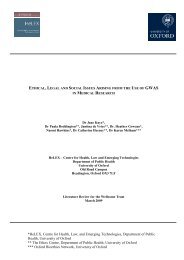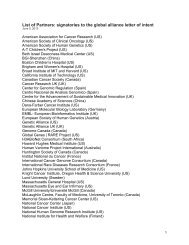Biobanks for Europe - European Commission - Europa
Biobanks for Europe - European Commission - Europa
Biobanks for Europe - European Commission - Europa
- No tags were found...
You also want an ePaper? Increase the reach of your titles
YUMPU automatically turns print PDFs into web optimized ePapers that Google loves.
C G49Recommendation 2There should be better coordination and collaboration between national oversight bodies (e.g.data protection authorities and ethics committees) as well as mutual recognition of decisionmakingto eliminate unnecessary duplication of oversight and compliance requirements, withtraining to support this.7.3• Engaging publics<strong>Biobanks</strong> involve many people and raise complex issues that concerns individual participants andtheir families but also the wider society. One of the challenges of biobanking has been how toengage potential recruits but also to canvas support from the wider public. The importance ofengaging the public in all aspects of biobank planning and establishment has been learnt throughsome of the more high-pro le biobanking projects. 138,139,140An example is Iceland, where a strong ethical and political body, Mannvernd – the Association ofIcelanders <strong>for</strong> Ethics in Science and Medicine – was <strong>for</strong>med in direct response to the databaseproject. 141 While the company deCODE genetics had developed a business plan and vision <strong>for</strong> itsbiobank project in Iceland, a gap had widened between some parts of the Icelandic society anddeCODE that at a certain point could no longer be reconciled. This example demonstrates that itcannot be taken <strong>for</strong> granted that societies are always in favor of all types of scienti c projectsespecially if they are large in scale. The common feature of biobanks is that they are dependenton taxpayers’ money and there<strong>for</strong>e require strong political support. Dierent biobank projects havefound unique ways to engage with their social environment and in bring together the most relevant‘publics’. To integrate dierent points of view and maintain support <strong>for</strong> a biobank is an importanttask in biobank governance <strong>for</strong> the future. 142 Public participation and involvement in biobankresearch and transparency in the operation of biobanks will be essential <strong>for</strong> linking up biobankresearch with the goal of responsible innovation.Another challenge has been how to engage participants in the long-term operation of biobanks.Currently, the examples of a real patient involvement in the creation and governance of a biobankare still exceptional, but there are examples within the rare disease patient community. This isdue in part to the limited knowledge that patients and patient groups have of the highly technical138 Haddow G, Cunningham-Burley S, Bruce A, Parry S: Generation Scotland: consultingpublicsconsultingpublics and specialists at an early stage in a genetic database’s development.Crit Public Health 2008; 18: 139–149.139 Godard B, Marshall J, Laberge C, Knoppers BM: Strategies <strong>for</strong> consulting with the community: thecases of four large-scale genetic databases. Sci Eng Ethics 2004; 10: 457–477.140 Burgess M, Tansey J: Technology, democracy, and ethics: democratic deficit and the ethics of publicengagement; in Einseidel E (ed): Emerging Technologies: From Hindsight to Foresight. Calgary,University of Calgary Press, 2008, pp 275–288.141 Palsson G. The rise and fall of a biobank: the case of Iceland. In: Gottweis H, Petersen A, editors.<strong>Biobanks</strong> Governance in comparative perspective. London: Routledge; 2008. pp. 41–55.142 Gottweis, H. & Lauss, G. (2011), Biobank governance: heterogeneous modes of ordering anddemocratization, Journal of Community Genetics, 12/2011, doi 10.1007/s12687-011-0070-0.





